Economic Development: April 2025 Current Affairs | Current Affairs & General Knowledge - CLAT PDF Download
Prawn Aquaculture in India
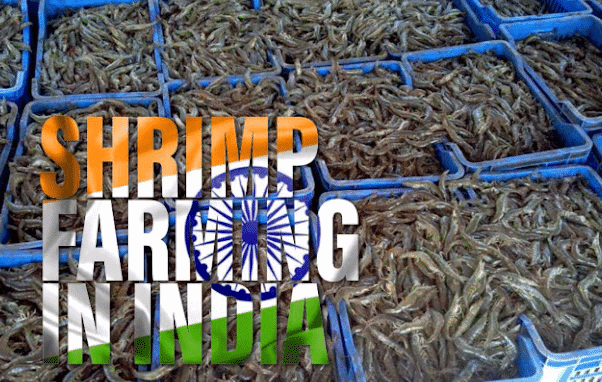
In Context
India, with its vast coastline and inland water resources, has become a global leader in aquaculture over the past two decades, particularly in prawn farming, while balancing economic and nutritional objectives.
What is Aquaculture?
Aquaculture refers to the controlled cultivation of aquatic species in various environments such as freshwater, brackish water, or marine settings. It complements traditional capture fisheries and plays a crucial role in meeting the increasing demand for animal protein, generating employment opportunities, and contributing to export revenues.Aquaculture can be categorized into the following types:
- Freshwater Aquaculture: Cultivation of aquatic species in freshwater bodies such as rivers, lakes, and ponds.
- Coastal Aquaculture: Farming of aquatic species in coastal areas, including estuaries and coastal lagoons.
- Sea Farming: Cultivation of marine species in open sea waters.
- Brackish Water Aquaculture: Farming of species in brackish water environments where freshwater and seawater mix, such as in mangrove areas.
India’s Remarkable Progress in Aquaculture
India has made significant strides in aquaculture and is now:
- The third-largest producer of aquaculture products globally.
- Second in the world for prawn production.
- Home to key aquaculture states such as Andhra Pradesh, West Bengal, Tamil Nadu, Odisha, and Gujarat.
A notable success story is India’s thriving black tiger prawn (Penaeus monodon) industry, which is in high demand for both domestic consumption and export.Factors Behind India’s High Growth in Aquaculture
- Geographic and Natural Advantages: India’s long coastline (11,098 km) and abundant brackish water zones provide a natural advantage for aquaculture. Coastal groundwater and tidal access help maintain the necessary water salinity levels (10–25 g/L) for prawn farming.
- Innovative Farming Techniques: The promotion of smaller ponds, such as those in Andhra Pradesh, has led to better yields and improved disease control. Farmers are now using controlled pond management practices and balancing salinity levels by mixing brackish water with river water.
- Private and Institutional Collaboration: Research institutions like ICAR-CIBA (Indian Council of Agricultural Research - Central Institute of Brackishwater Aquaculture) have played a vital role in developing ‘specific pathogen-free’ (SPF) broodstock. The growth of aquafeed industries and laboratories for disease detection has further supported aquaculture development.
Challenges in Aquaculture
- Disease Outbreaks: Pathogens such as Vibrio harveyi and the White Spot Syndrome Virus can cause significant yield losses, sometimes up to 25% annually.
- Environmental and Climate Change Pressures: Changes in salinity, water temperature variations, and extreme weather events pose risks to production cycles.
- Infrastructure and Resource Gaps: There is a need for improved access to testing laboratories, biosecure hatcheries, and cold chain logistics, especially in remote regions.
Key Government and Research Initiatives
- ICAR-CIBA: The institute is at the forefront of developing specific pathogen-free prawn stocks and promoting phage therapy to combat bacterial diseases.
- Government Schemes: Initiatives like the PM Matsya Sampada Yojana provide skill training, credit access, and support for small-scale farmers.
- Diagnostic Services: The establishment of laboratory networks and diagnostic services helps in early monitoring and containment of infections.
Way Ahead
To sustain growth and enhance climate resilience in aquaculture, India needs to:
- Scale up the production of biosecure hatcheries and expand SPF broodstock production.
- Encourage research and development in feed efficiency, breeding, and disease resistance.
- Improve cold chain logistics and export infrastructure.
- Promote digital aquaculture management systems, especially for small farmers.
- Integrate environmental sustainability practices, such as mangrove-friendly shrimp farming.
Periodic Labour Force Survey 2024

Why in News?
The Ministry of Statistics and Programme Implementation (MoSPI) has released the Periodic Labour Force Survey (PLFS). This data is vital for understanding the shifting dynamics of India's labour market in both rural and urban contexts.
Key Takeaways
- Labour Force Participation Rate (LFPR) in urban areas increased for males (from 74.3% to 75.6%) and slightly for females (from 25.5% to 25.8%), raising the overall urban LFPR to 51.0%. The all-India LFPR remained stable at 56.2%.
- The Worker Population Ratio (WPR) in urban areas increased slightly from 47.0% to 47.6%, while the all-India WPR stayed nearly the same at 53.5%.
- The Unemployment Rate (UR) in rural areas decreased slightly to 4.2%. Urban male UR increased, urban female UR decreased, resulting in an overall urban UR of 6.7%. The all-India UR dropped from 5.0% to 4.9%.
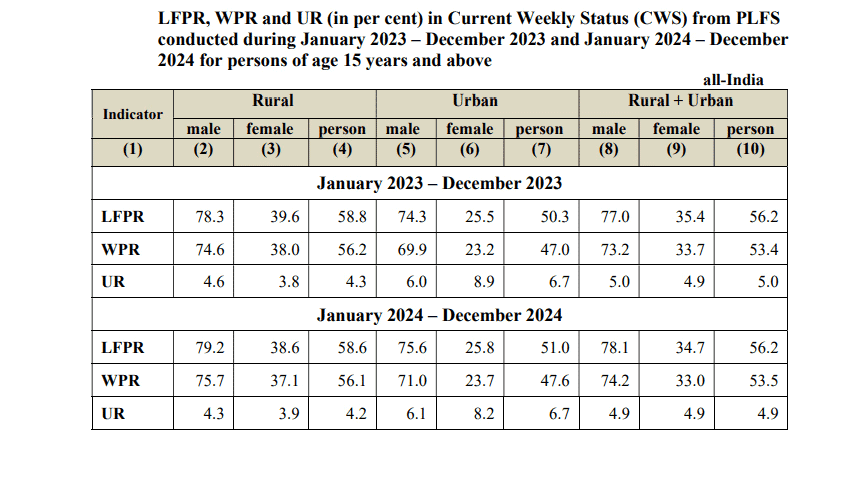
Labour Force Indicators in Principal and Subsidiary Status (PS+SS)
- LFPR: Remained largely stable nationally, with a slight decline from 59.8% to 59.6%.
- WPR: All-India WPR slightly decreased from 58.0% to 57.7%, indicating a minor drop in employment.
- UR: All-India UR increased slightly from 3.1% to 3.2%, with varying trends across different sectors.
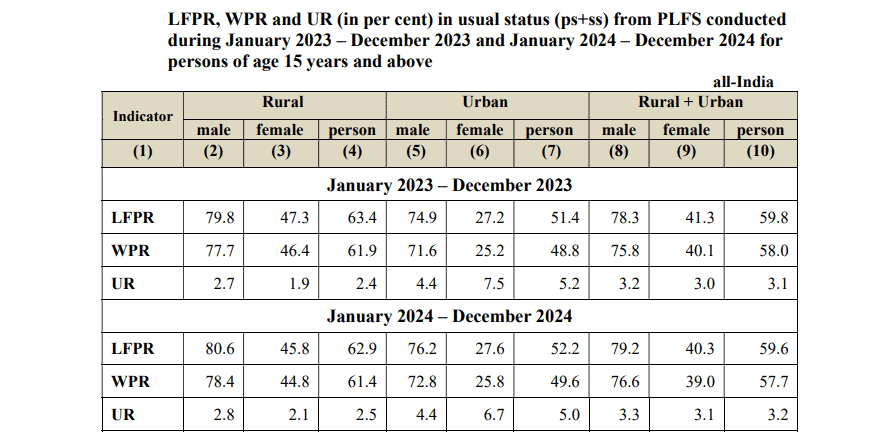
Concerns Regarding India’s Labour Force
- Gender Gaps: The female LFPR is significantly lower than that of males, with urban female unemployment at 8.2%. Only 3% of employed women over 25 have advanced degrees, indicating an underutilization of educated women.
- Stagnation in Employment: WPR and LFPR show minimal year-on-year change, suggesting sluggish job creation and a disconnect between employment growth and economic growth.
- Youth Unemployment: A significant portion of the unemployed is youth, particularly those with secondary or higher education. The youth unemployment rate in India was 10.2% in 2023-24, compared to the global average of 13.3%.
- Low Productivity: India has one of the longest average workweeks globally at 46.7 hours, yet labour productivity remains low, with a GDP per working hour of just USD 8.
- Rural Employment Dependence: Many rural workers are engaged in low-productivity or subsistence jobs, leading to underemployment and insecurity.
Recommendations for Improving India’s Labour Force
- Bridge the Skill-Industry Mismatch: Promote outcome-based skilling through partnerships with the National Skill Development Corporation (NSDC) and integrate the Future Skills Prime ecosystem.
- Drive Formalization with Inclusivity: Implement a 'one-nation, one-registration' system for unorganized workers and facilitate micro-credit access for MSMEs.
- Institutionalize Urban Employment and Mobility: Scale urban wage employment models and create labour mobility corridors with necessary support for migrant workers.
- Leverage Climate Transition for Job Creation: Invest in green sectors to create jobs that also benefit the environment.
- Design Gendered Labour Reforms: Pilot indices to map constraints affecting women's workforce participation and link CSR spending with women's skilling initiatives.
- Incentivize Employers: Offer Employment-Linked Incentive Schemes (ELI) to encourage the creation of formal jobs and provide fiscal benefits for inclusive hiring practices.
In conclusion, despite significant economic growth, India grapples with persistent issues of jobless growth and youth unemployment. Addressing these challenges requires a multifaceted approach, focusing on skill development, formalization of employment, and inclusivity to enhance the overall effectiveness of the labour market.
Debt Metrics

Recent Trends in India’s External Debt
- According to the Finance Ministry’s Quarterly External Debt Report for December 2024, India’s external debt has increased by 10.7% since December 2023, primarily due to the valuation effect.
- The valuation effect refers to the impact of the appreciation of the US dollar against the Indian rupee.
Key Highlights from the Report
- External Debt to GDP Ratio: The ratio increased slightly to 19.1% in December 2024, up from 19.0% in September 2024.
- Composition: Debt and loans denominated in US dollars constituted the largest portion of external debt.
- Debt Service: The total debt service, which includes principal repayments and interest payments, declined by 0.1% between September and December 2024.
- Long-Term vs. Short-Term Debt: Long-term debt saw a slight increase, while short-term debt experienced a marginal decline.
Understanding External Debt
- Definition: External debt refers to money borrowed from sources outside the country by the Central Government and corporations through External Commercial Borrowings.
- Currency Denomination: External debt is predominantly denominated in foreign currencies such as the US dollar and Special Drawing Rights (SDR).
- Sources: External debt can be sourced from foreign commercial banks, international financial institutions like the IMF and World Bank, or foreign governments.
Challenges Associated with Rising External Debt
- Repayment Burden: External debt is often denominated in foreign currencies, making it susceptible to exchange rate fluctuations that can impact the repayment burden.
- Rising Inflation: Prolonged inflation can lead to higher interest rates, slowing economic growth and increasing the external debt to GDP ratio.
- Global Scenario: The global threat of stagflation could reduce demand for India’s exports, adversely affecting the debt service ratio.
Climate-Driven Economic Losses in Asia-Pacific
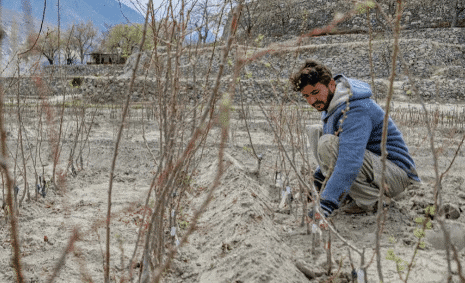
Why in News?
According to a UN report, climate shocks could lead to annual economic losses of at least 6% in a third of Asia-Pacific countries.
About Climate Change
- Climate change refers to the long-term alteration of temperature, rainfall, wind patterns, and other climatic factors, which can occur over decades or even longer. Throughout millions of years, our planet has experienced periods of both warmth and cold.
Incidences of Climate Shocks
Temperature Rise:
- The Earth is currently about 1.2°C warmer than during the pre-industrial era (1850-1900), based on the global average temperature from the recent decade (2014-2023).
- 2023 set a record as the warmest year, with the global average near-surface temperature approximately 1.45°C above the pre-industrial baseline.
- The decade from 2011 to 2020 was the warmest on record for both land and ocean.
Rising Sea Levels:
- Global sea levels have increased by 8–9 inches (21–24 cm) since 1880.
- This rise has accelerated to 3.6 mm/year during the period from 2006 to 2015, which is 2.5 times faster than the rates observed in the 20th century.
Increasing Severe Storms and Cyclones:
- Warmer ocean temperatures provide more energy for storms, while altered wind patterns contribute to their intensity.
- For instance, by April 2025, 461 tornadoes were recorded, including 59 EF-2 or stronger twisters.
- An EF-3 tornado in Tennessee, with winds of 160 mph, resulted in five fatalities.
Jet Stream Disruption:
- Warming in the Arctic reduces temperature gradients, which weakens the polar vortex winds.
- This early collapse of the polar vortex has shifted winds to an easterly direction, causing cold snaps in regions like the U.S. and Europe.
- The increased "waviness" in jet streams is linked to prolonged droughts and heatwaves, such as the 2021 heat dome in the Pacific Northwest of the United States.
Key Drivers of Climate Shocks
Greenhouse Gas Emissions:
- The buildup of gases like carbon dioxide (CO₂), methane (CH₄), and nitrous oxide (N₂O) in the atmosphere leads to increased heat retention, exacerbating climate irregularities.
Ocean-Atmosphere Interactions:
- Phenomena such as El Niño, La Niña, and the Indian Ocean Dipole significantly alter rainfall distribution, intensifying droughts and floods, and disrupting monsoon patterns.
- For example, the 2015 El Niño caused severe droughts in southern Africa and Indonesia while causing flooding in parts of South America.
Deforestation and Land Use Changes:
- The clearing of forests diminishes the Earth’s capacity to absorb carbon, disrupts water evaporation patterns, and alters local heat absorption (albedo), creating detrimental regional feedback loops.
- For instance, deforestation in the Amazon is leading to reduced rainfall in southern Brazil, increasing the frequency of droughts in that region.
Aerosol and Black Carbon Emissions:
- While aerosols can have a cooling effect by reflecting sunlight, black carbon contributes to warming by absorbing heat and settling on snow, which accelerates melting.
- Black carbon emissions from the Indo-Gangetic Plain have been associated with rapid glacial retreat in the Himalayas.
Climate Change Threat to Macroeconomic Stability in Asia-Pacific
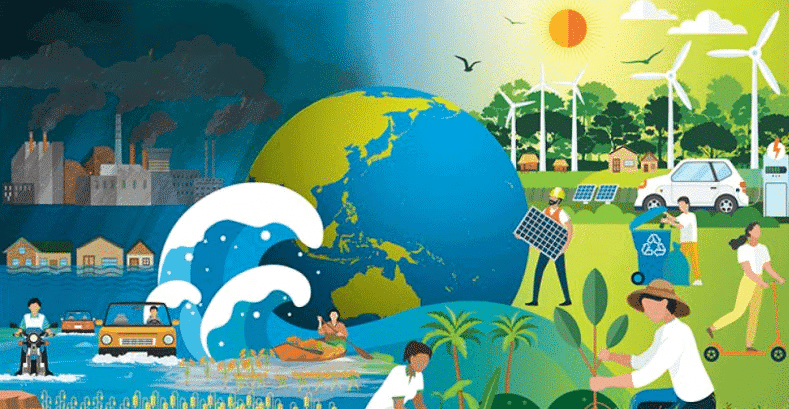
Average Annual Loss (AAL):
- The United Nations Economic and Social Commission for Asia and the Pacific (UNESCAP) uses the AAL metric to estimate yearly economic damages from disasters.
- This metric considers factors such as hazard frequency, severity, exposure levels, and societal vulnerability.
- On average, AAL constitutes 4.8% of GDP among the 30 Asia-Pacific nations studied.
- However, some countries face significantly higher economic risks, such as Cambodia (nearly 11%), and Fiji, Myanmar, and Pakistan (at least 7%).
Vulnerability of Developing Economies:
- Among the 30 countries assessed, 11 developing economies are particularly vulnerable to climate-related macroeconomic shocks. These include:
- Afghanistan, Cambodia, Iran, Kazakhstan, Laos, Mongolia, Myanmar, Nepal, Tajikistan, Uzbekistan, and Vietnam.
- These countries are experiencing rapid urban expansion and have underdeveloped infrastructure, especially in coastal areas, which increases their climate risk and contributes to rising economic losses.
- Despite being projected to drive 60% of global economic growth in 2024, many of these nations lack the necessary adaptive capacity to cope with climate-induced disruptions effectively.
Sectoral Exposure:
- The agriculture sector is highly vulnerable, with projections indicating a decline in rice yields of up to 14% by 2050. This poses significant threats to food security and the livelihoods of farmers in countries like India.
- Economies heavily reliant on fossil fuels, such as Indonesia, India, and China, face considerable economic disruptions due to the ongoing transition towards renewable energy. This shift could lead to widespread job losses and decreased state revenues.
- The fisheries sector is also expected to be adversely affected, with fish stocks in tropical regions estimated to decline by up to 30% by 2050. This decline undermines food systems and coastal economies that depend on fishing.
Major Climate Change Impacts on India’s Economy
India’s Economic Impact:
- The Asian Development Bank (ADB) estimates that climate change could lead to a reduction of 24.7% in India’s GDP by 2070, significantly hampering economic growth.
- Rising temperatures are expected to result in more frequent and severe heatwaves in India. The World Bank (2022) projects that by 2030, India could account for 34 million job losses out of a global total of 80 million job losses attributed to heat stress reducing productivity.
- Additionally, 4.5% of India’s GDP may be at risk due to decreased working hours caused by extreme heat and humidity.
Agricultural Decline:
- Increasing temperatures and unpredictable rainfall patterns are leading to reduced crop yields, particularly for staples like rice and wheat.
- The World Bank warns that if global temperatures rise by 2°C by the 2050s, India may need to import more than twice the amount of food grain compared to a scenario without climate change.
Rising Sea Levels:
- India, with its 7,500 km coastline, is highly susceptible to rising sea levels. Between 1990 and 2018, 32% of its shores experienced erosion.
- Major coastal cities like Mumbai and Kolkata are facing increasing threats of flooding, while regions like the Sundarbans could lose up to 80% of their area by 2100 due to rising sea levels.
Extreme Weather Events:
- According to the Germanwatch’s Climate Risk Index (1993–2023), India ranks 6th among the most climate-vulnerable nations.
- Over the past 30 years, India has experienced more than 400 extreme weather events, resulting in economic losses of USD 180 billion and over 80,000 deaths due to these events.
Way Forward to Curb Climate-Driven Economic Losses
Embrace Circular Economy:
- Asia-Pacific nations should adopt circular economy models, where waste from one sector is used as a resource in another. This approach reduces emissions and optimizes resource efficiency.
- India can take the lead by developing Zero Waste Cities through Waste-to-Wealth programs, minimizing landfill dependence and maximizing material reuse.
Foster Green Innovation:
- Support climate-tech startups focused on breakthrough solutions such as carbon capture, renewable energy storage, and clean production technologies.
- India can accelerate green innovation by leveraging initiatives like the Atal Innovation Mission and Startup India, while securing additional funding from the Green Climate Fund (GCF) to scale sustainable solutions.
Climate-Resilient Infrastructure:
- Invest in flood-resistant urban planning and heat-proof construction to protect cities from extreme weather events.
- India should integrate climate adaptation into the Smart Cities Mission and the National Action Plan on Climate Change (NAPCC).
- Creating climate-smart Special Economic Zones (SEZs) with sustainable infrastructure, similar to the UAE’s Masdar City, can attract eco-friendly industries and promote green growth.
Green Taxonomy:
- India should establish a clear green classification system to direct investments toward sustainable sectors. This system should align with the NAPCC to enhance transparency in green financing.
Global Climate Funds:
- Financial mechanisms like the Loss and Damage Fund (LDF) are crucial for helping Asia-Pacific countries build climate resilience, adopt sustainable agriculture, and transition to renewable energy.
- Expanding the reach and funding of the LDF is essential for effective climate adaptation across vulnerable regions.
10th Anniversary of Pradhan Mantri Mudra Yojana
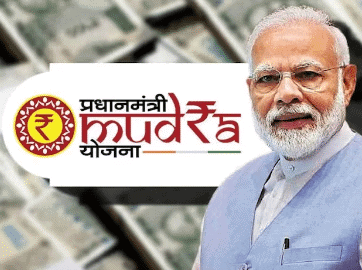
Why in News?
On April 8, 2025, the Pradhan Mantri Mudra Yojana (PMMY) celebrated its 10-year milestone since its inception in 2015. This initiative has been crucial in offering collateral-free financial assistance to micro and small enterprises (MSEs) throughout India.
Key Takeaways
- Credit Outreach: Over Rs 32.61 lakh crore has been disbursed through 52 crore loans, benefiting more than 100 million first-time borrowers.
- Growth in MSME Lending: MSME lending increased from Rs 8.5 lakh crore in FY14 to Rs 27.25 lakh crore in FY24, with its share in bank credit rising from 15.8% to nearly 20%.
- Inclusive Financial Access: Women make up 68% of PMMY beneficiaries, with per woman loan disbursement growing at a CAGR of 13% from FY16 to FY25.
- Pandemic Support: The 2% interest subvention on Shishu loans under Atma Nirbhar Bharat helped prevent defaults and safeguarded livelihoods during the Covid-19 pandemic.
- Maturing Credit Demand: There has been a shift from small Shishu loans (declining from 92% to 63%) towards higher Kishor loans (increasing from 5.9% to 44.7%).
- Regional Reach: Tamil Nadu, Uttar Pradesh, and Karnataka lead in total PMMY disbursals, while Tripura, Odisha, and Tamil Nadu rank highest in per capita loans.
Additional Details
- Regional Performance: Jammu & Kashmir leads among Union Territories in loan disbursal, while states like Bihar and West Bengal show considerable untapped potential.
- Impact on Beneficiaries: Half of PMMY accounts are held by SC, ST, and OBC entrepreneurs, with 11% of accounts managed by minority communities, according to SBI data.
The Pradhan Mantri Mudra Yojana has significantly contributed to the financial empowerment of small businesses and entrepreneurs across India, marking a decade of impactful change in the country's economic landscape.
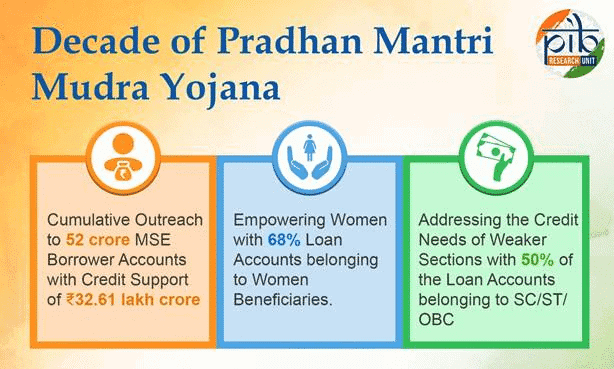
Urban Transport in India
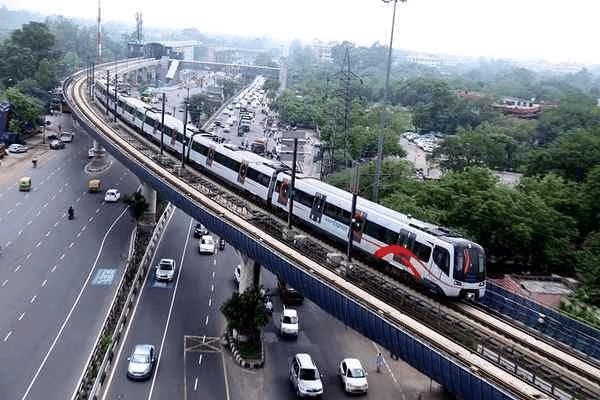 Why in News?
Why in News?
Bengaluru’s Namma Metro has recently become the most expensive metro service in India following a significant fare increase in February 2025. This decision has sparked concerns about the affordability of urban transport, as high fares can erode commuter trust in public transport systems.
Key Takeaways
- Affordability issues arise from rising fares in metro and bus services, affecting low- and middle-income groups.
- Weak non-motorised transport infrastructure leads to unsafe commuting conditions.
- Severe traffic congestion diminishes urban mobility and productivity.
- Environmental impacts from the transport sector contribute significantly to pollution and health problems.
- Inadequate public transport systems hinder accessibility in many urban areas.
- Financial constraints limit Urban Local Bodies (ULBs) in developing sustainable transport solutions.
Additional Details
- Affordability: Rising fares, such as Bengaluru's Rs 90 for over 30 km, make commuting increasingly costly, particularly for lower-income groups. Surge pricing by mobility apps further complicates affordability.
- Weak Non-Motorised Transport (NMT) Infrastructure: Many Indian cities lack safe pedestrian zones and cycling tracks, with pedestrian fatalities exceeding 40% in cities like Delhi and Bengaluru. Poorly designed or encroached paths deter their use.
- Congestion: Despite serving less than 20% of commuters, private vehicles occupy 90% of road space, leading to significant traffic congestion and long commute times.
- Environmental Impact: The transport sector was responsible for 14% of India's energy-related CO₂ emissions in 2020. Vehicles are major sources of PM2.5 and NOx emissions, particularly in polluted cities like Delhi, jeopardizing health and environmental goals.
- Inadequate Public Transport Systems: Only 63 out of 458 cities with populations over 100,000 have formal bus services. India has just 1.2 buses per 1,000 people, far below global benchmarks.
- Financial and Capacity Constraints: Urban Local Bodies (ULBs) struggle with financial autonomy and depend heavily on state funding, limiting their ability to implement sustainable transport projects.
To address these challenges and promote sustainable and inclusive urban mobility, several strategies can be implemented:
- Investment in NMT: With nearly 50% of urban trips under 5 km, investing in dedicated lanes for walking and cycling can enhance urban mobility.
- Adopt Best Practices: Cities like Kochi, Bhubaneswar, and Srinagar exemplify effective transport systems that can serve as models for other urban areas.
- Affordable Public Transport Access: Implementing subsidized fare structures and exploring non-fare revenue sources can reduce commuting costs.
- Clean Transport: Initiatives like FAME II and PM e-Bus Sewa can promote electric mobility and reduce reliance on fossil fuels.
- Empower ULBs: Enabling ULBs to use land value capture and other financing mechanisms can support sustainable transport services.
- Integrated Public Transport Systems: Funding for integrated systems that prioritize people over vehicles can facilitate seamless transport and reduce private vehicle dependency.
In conclusion, addressing the multifaceted issues in urban transport in India requires a coordinated approach that focuses on affordability, infrastructure development, environmental sustainability, and financial empowerment of local bodies.
Reforming Indian Railways
 Why in News?
Why in News?
The recent audit report by the Comptroller and Auditor General (CAG) on the Ministry of Railways has brought to light several concerns regarding the functioning of Indian Railways, highlighting the need for reform and modernization.
Key Takeaways
- Indian Railways, the fourth largest network globally, spans over 65,000 km and carried 8 billion passengers and 1.4 billion tons of freight in 2022.
- The government plans a massive investment of USD 750 billion in railway infrastructure by 2030.
- Indian Railways aims for net zero carbon emissions by 2030, with plans to operate hydrogen trains.
Additional Details
- Comptroller and Auditor General (CAG): This body conducts audits to ensure accountability in government financial operations, and its recent findings underscore critical areas needing improvement in Indian Railways.
- KAVACH: An innovative Train Collision Avoidance System that aims to enhance safety; however, its limited deployment raises concerns about its effectiveness.
- Vande Bharat Train: A semi-high-speed train featuring modern amenities aimed at improving passenger experience and operational efficiency.
- Dedicated Freight Corridors (DFCs): Infrastructure projects intended to facilitate faster and more efficient freight transport, though progress has been slow with only some corridors operational.
In conclusion, while Indian Railways serves as a vital economic engine for the country, addressing its operational challenges through strategic reforms and investments is crucial for enhancing efficiency, safety, and service quality.
Commission on Genetic Resources for Food and Agriculture
Why in News?
Recently, parties to the Commission on Genetic Resources for Food and Agriculture convened in Rome for their 20th meeting (CGRFA-20), highlighting ongoing discussions and developments in the area of genetic resources for food and agriculture.
Key Takeaways
- The Commission was established by the Food and Agriculture Organization (FAO) in 1983 to address plant genetic resources (PGR).
- It serves as the primary international forum for governments to discuss and negotiate matters related to genetic resources for food and agriculture (GRFA).
- The Commission's mandate has expanded to include all sectors of GRFA, encompassing plant, animal, forest, aquatic, and microbial genetic resources.
- Key topics include food security, nutrition, human health, climate change adaptation, and access to genetic resources.
- The Commission has 179 member countries, including India.
Additional Details
- International Treaty on Plant Genetic Resources for Food and Agriculture (ITPGRFA): Adopted on 3 November 2001, this treaty acknowledges the contributions of farmers to crop diversity and establishes a global system for accessing plant genetic materials.
- The Commission has achieved significant milestones, such as the Global Plan of Action for Animal Genetic Resources (GPA), initiated in 1997 and culminating in a report in 2007.
The Commission on Genetic Resources for Food and Agriculture continues to play a critical role in ensuring the sustainable use and conservation of genetic resources vital for global food security and agricultural biodiversity.
India's Cotton Crisis - From Self-Sufficiency to Import Dependence
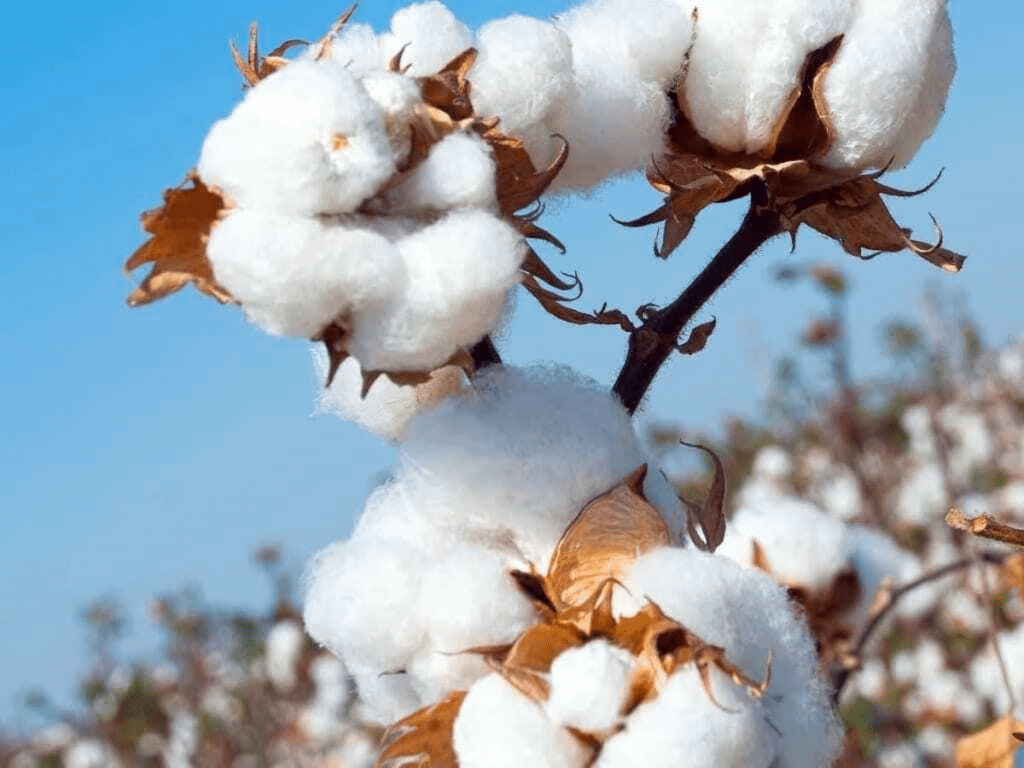 Why in News?
Why in News?
The situation surrounding India's cotton production has shifted dramatically. Once a prominent producer and exporter, India is now grappling with a significant drop in cotton output, resulting in a reliance on imports. This crisis stems primarily from domestic policy issues and restrictions on genetically modified (GM) crops rather than external pressures.
Key Takeaways
- India has transitioned from being a leading cotton producer to a net importer.
- The decline in cotton production is largely attributed to policy paralysis and regulatory challenges regarding GM crops.
- Technological advancements played a crucial role in the past surge of cotton production.
Additional Details
- Technological Advancements: The introduction of hybrid and GM cotton significantly boosted yields. For instance, the first cotton hybrid, H-4, developed in 1970, and the introduction of GM Bt cotton in 2002-03, which provided pest resistance, led to a peak yield of 566 kg per hectare.
- Declining Production: Cotton production surged from 13.6 million bales in 2002-03 to 39.8 million bales in 2013-14, but projections for 2024-25 indicate a drop to 29.5 million bales, the lowest since 2008-09.
- Regulatory Challenges: Restrictions on GM technology and regulatory hurdles have hindered research and development. The 2010 moratorium on GM Bt brinjal exemplifies the ongoing resistance to GM crop approvals.
- Economic Implications: India, once a major cotton exporter, is now facing increased import costs, which doubled in value from $518.4 million to $1,040.4 million in 2024-25.
- Need for Policy Reforms: There is an urgent requirement for policy measures that prioritize scientific validation over activist-driven opposition, encouraging domestic production through technological adoption.
The crisis in India's cotton sector highlights the pressing need for a balanced, science-driven agricultural policy. The failure to adapt and embrace advancements in biotechnology has not only harmed farmers but has also resulted in increased dependence on foreign cotton, reshaping trade dynamics and benefiting global competitors like the US and Brazil.
|
98 videos|923 docs|33 tests
|
















